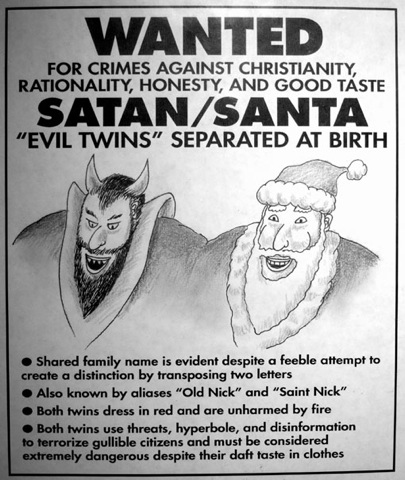
Separated at birth
And another link linking Santa to Satan… and this one even mentions Harry Potter for good measure.
If the most productive time of salvation are the pre-teen years, and if the pre-teen years are the most vulnerable – does it not stand to reason that Satan would fiercely attack this time? Can we not see the overwhelming evidence of this Satanic attack on our children? From the sexual, sensual music of Britney Spears, or Nsync, to the occult and witchcraft of Harry Potter – there is an attack aimed directly at our children. It is assaulting them from the TV, the music, the Internet, the peer pressure, the public schools – Satan literally “seeks” to “devour our children” into every nook and cranny.
A bit of reductio ad Harry Potterium, and reductio ad NSyncium for good measure (nb only funny if you know that reductio ad Hitlerum is the practice of introducing Hitler into a logical argument – also fulfilling Godwin’s Law). My favourite quotes on Santa:
The Devil is a master of disguise. He can make it appear good, pleasant, and seemingly so innocent – and yet it is deadly! The Bible says in 2 Corinthians 11:14, “And no marvel; for Satan himself is transformed into an angel of light” He does not appear with horns and a pitch fork breathing fire. He might just appear as a pleasant, friendly, fellow, with “a broad face and a round little belly, That shook when he laughed, like a bowl full of jelly… “
Actually, this bit is quite bizarre – and very long. But it’s interesting reading… Basically Santa = Thor = Satan. In summary Santa and Thor both enter buildings via chimneys and so are invulnerable to fire… just like Satan. Coca Cola just added fuel to the fire by painting Santa red. Therefore coca cola is devil water…
The unusual and common characteristics of Santa and Thor are too close to ignore.
* An elderly man, jovial and friendly and of heavy build.
* With a long white beard.
* His element was the fire and his color red.
* Drove a chariot drawn by two white goats, named called Cracker and Gnasher.
* He was the Yule-god. (Yule is Christmas time).
* He lived in the Northland (North Pole).
* He was considered the cheerful and friendly god.
* He was benevolent to humans.
* The fireplace was especially sacred to him.
* He came down through the chimney into his element, the fire.Even today in Sweden, Thor represents Santa Claus. The book, The Story of the Christmas Symbols, records:
Swedish children wait eagerly for Jultomten, a gnome whose sleigh is drawn by the Julbocker, the goats of the thunder god Thor. With his red suit and cap, and a bulging sack on his back, he looks much like the American Santa Claus. (Barth, Edna. Holly, Reindeer, and Colored Lights, The Story of the Christmas Symbols. New York: Clarion Books, 1971, p. 49)
Thor was probably history’s most celebrated and worshipped pagan god. His widespread influence is particularly obvious in the fifth day of the week, which is named after him – Thursday (a.k.a. Thor’s Day).
It is ironic that Thor’s symbol was a hammer. A hammer is also the symbolic tool of the carpenter – Santa Claus. It is also worth mentioning that Thor’s helpers were elves and like Santa’s elves, Thor’s elves were skilled craftsman. It was the elves who created Thor’s magic hammer.
In the Handbook of Christian Feasts and Customs, author Francis Weiser traces the origin of Santa to Thor: “Behind the name Santa Claus actually stands the figure of the pagan Germanic god Thor.” (Weiser, Francis X. Handbook of Christian Feasts and Customs. New York: Harcourt, Brace & World, Inc., 1952, p. 113)
After listing some the common attributes of Thor and Santa, Weiser concludes:
Here, [Thor] then, is the true origin of our “Santa Claus.” . . . With the Christian saint whose name he still bears, however, this Santa Claus has really nothing to do. (Weiser, Francis X. Handbook of Christian Feasts and Customs. New York: Harcourt, Brace & World, Inc., 1952, p. 114)
Another interesting trait of Thor is recorded by H.R. Ellis Davidson in Scandinavian Mythology, “It was Thor who in the last days of heathenism was regarded as the chief antagonist of Christ.” (Davidson, H.R. Ellis. Scandinavian Mythology. New York: Peter Bedrick Books, 1982, p. 133) In case you are not aware, an “antagonist” is an enemy, adversary or replacement.
The bizarre and mutual attributes of Thor and Santa are no accident.
It’s funny, because I always thought Thor looked more like this:
